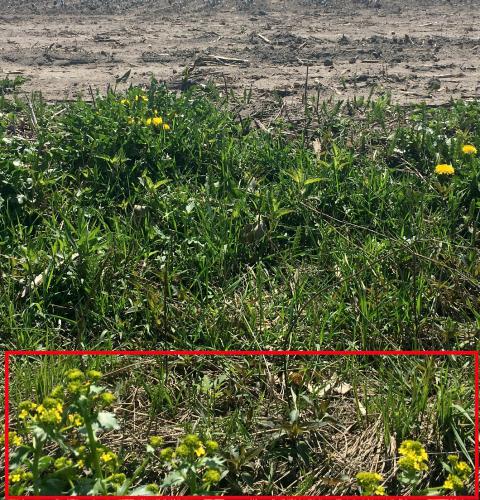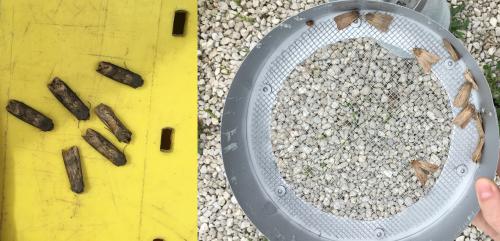Southeast Michigan vegetable update – April 26, 2017
A wet spring hasn’t hindered growers, as field preparation and planting occurs (just remember pests and disease are similarly unhindered).
Weather
This spring has been one of the wettest on record in some parts of Michigan, but dry days in the last few weeks allowed some field activities to occur. Looking ahead, cooler weather and more rain is on the way through the end of the week.
The table below presents rainfall (in inches) for the Michigan State University Enviroweather stations in southeast Michigan, as well as degree-days calculated using the Baskerville-Emin Method. For a refresher on degree-days and how to get this information in your area, see the MSU Extension article, “Accessing growing degree days with Enviro-weather.”
| Rainfall and degree-day (DD) totals as of April 26, 2017 | ||||
|---|---|---|---|---|
| Station | DD base 42 | DD base 50 | 5-year DD average base 50 | Rainfall since April 1 (inches) |
| Commerce | 298 | 129 | 101.6 | 2.57 |
| Deerfield | 383 | 176 | NA | 2.17 |
| Hudson | 297 | 125 | 125.4 | 2.38 |
Crops
Broccoli transplants have been planted at many operations.
Cabbage transplants are out. MSU Enviroweather models suggest cabbage maggot adults have emerged and are flying April 20 in Deerfield, and expect egglaying to peak 192 more degree-days. A quick way to estimate if adults are flying in your area is to look for blooming yellow rocket, which flowers at the same time as flies emerge. This all signals that flight is occurring and damage can occur in cole crops transplanted during this time if no control measures are taken. For more information on cabbage maggot, see my article, “Early-emerging cabbage maggot mows down and tunnels through roots of cole crops.”

The yellow rocket flowers (in box) in this field edge boarding a red cabbage planting indicate it’s the time in spring where cabbage maggot flies are out. Image courtesy of Marissa Schuh, MSU Extension.
Carrot planting has begun.
Garlic has started to emerge.
Onions and shallots are being planted.
Pepper and tomato transplants have been started. Earlier this month the damp, cloudy days led to damping off in some greenhouses, and the risk will peak again later this week as cool, wet weather moves in again. Tomato transplants in particular are at risk of bacterial diseases in many greenhouses. Cultural controls are important in both situations; work to increase airflow with ventilation or fans, carefully monitor moisture and water transplants at a time of day when the leaves will be able to dry quickly. If you see bacterial or damping off symptoms, dispose of any afflicted trays to remove inoculum.
For bacterial disease in tomato transplants, other measures to reduce the incidence of bacterial disease will be key in getting healthy plants in the field. A good program will involve not only sprays a least weekly, but also sprays that occur before symptoms begin to appear. Once symptoms appear, afflicted plants cannot be “cured,” and sprays will only aide in the disease from spreading (i.e., if the outbreak is limited to one area in a greenhouse).
A tomato transplant program aimed at preventing bacterial diseases should include copper and streptomycin. Copper products should be chosen carefully; account for the product’s metal content (more copper will provide better efficacy, look at label for what percent of product is copper), metallic copper per unit (how much of formula’s weight is copper) and particle size (smaller particles equal better coverage). An explanation of what to look for in a copper product as well as comparison of products can be found in the MSU Extension “Copper formulations for fruit crops.” Keep in mind that not all of the products listed will be available in greenhouse vegetables.
Streptomycin can be used before transplanting and can be sprayed as a tank-mix with copper. Avoid leaving tank-mix for too long (more than 10 hours) before spraying, as it is unknown if the streptomycin will remain effective. For more information on copper formulations and streptomycin, see MSU plant pathologist Mary Hausbeck’s article, “Protect tomato transplants in the greenhouse from bacterial diseases.”
Early season sweet corn has been planted across the region, be it under tunnels, into black plastic or in the field. Emergence has been good so far. Enviroweather models suggest adult seed corn maggot has already reached peak emergence and egglaying, which was estimated to be April 16 in Deerfield. If stand emergence is poor, this may be the culprit.
Storms April 19–20 brought some early season moth pests in from other areas. These pests don’t have thresholds like corn earworm does, instead using “intensive capture,” which refers to a date set when large captures occur from which degree-days are counted up to when caterpillar emergence would be expected.
My black cutworm moth trap in Lenawee County captured six moths between April 19 and 21, one moth between April 21 and 22, and four moths between April 22 and 25. An intensive capture for black cutworm is eight to nine moths trapped in a two-day span, so at least in the trapping location we haven’t had a major flight yet. It is important to note that the number dropped can vary by location, so if you have a field with a lot of winter annual weeds or a late terminated spring cover crop, scouting may be warranted. For more information on black armyworm, see my article, “Black cutworms snip sweet corn seedlings early in the season.”
My true armyworm trap in Monroe County caught caught a total of three moths. I am also experimenting with a new trap type, which has caught higher numbers. Armyworm is most likely to impact sweet corn that has been no-till planted into grass or in sweet corn fields bordering wheat.

Black cutworms (left) are large, dark moths. Armyworms (right) are sturdy, buff-colored moths. Both are flying in southeast Michigan thanks to recent weather patterns. Image courtesy of Marissa Schuh, MSU Extension.
|
Pest |
County |
Trap catch |
Intensive capture? |
|---|---|---|---|
|
Black cutworm |
Lenawee |
11 |
No |
|
True armyworm |
Monroe |
3 |
No |
Potatoes are being planted.
Contact me at any time with questions, either at 517-264-5309 or schuhmar@msu.edu.
Meetings
It is never too early to make accommodations to attend Great Lakes Fruit and Vegetable EXPO, Dec. 5-7, 2017, in Grand Rapids, Michigan. The combination of grower-focused, research-backed presentations and an amazing exhibit hall make it a can’t-miss event.



 Print
Print Email
Email

